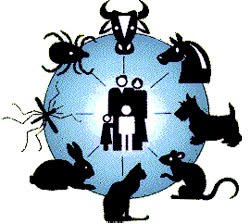Note: RVF used as a bio-weapon in US; http://en.wikipedia.org/wiki/Rift_Valley_fever
RIFT VALLEY FEVER, ANIMAL - NAMIBIA (04): FAO
*********************************************
A ProMED-mail post
ProMED-mail is a program of the
International Society for Infectious Diseases
Date: Wed, 28 Jul 2010
Source: FAO NEWS Release 10/62 en [edited]
FAO Director-General Jacques Diouf yesterday [Tue 27 Jul 2010]
commended Namibia for acting swiftly and effectively to halt the
spread of Rift Valley fever (RVF) in the country during recent
outbreaks.
Speaking at a meeting in the Ministry of Agriculture, Water and
Forestry in Windhoek, Diouf praised the Namibian institutions
involved. "Their alertness and prompt reaction prevented outbreaks of
RVF in May 2010 from spreading, with potentially devastating
consequences on lives, livelihoods and food security," Diouf said.
Diouf singled out the Meat Board of Namibia, the abattoirs where the
disease was detected, the Directorate of Veterinary Services and the
livestock farmers concerned.
The vigilance and response of the veterinary services was all the more
remarkable, Diouf said, when considering that RVF emerged in Namibia
after an absence of 25 years; almost all the staff involved had never
had to fight the disease before.
RVF is a disease carried by mosquitoes after heavy rains and flooding
and is characterised by high rates of abortion and neonatal mortality,
primarily in sheep, goats and also cattle. Humans are at risk -- and
can die -- when in close contact with the blood or organs of infected
animals or when bitten by infected mosquitoes.
An FAO team comprising members of the Animal Production and Health
Division and the Emergency Centre for Transboundary Animal Diseases
deployed at the request of the government returned from Namibia full
of praise for the professional performance of the veterinary services
in handling the outbreaks. Dr Juan Lubroth, FAO's Chief Veterinary
Officer said: "The swift response is exemplary and very likely
prevented worse from happening."
RVF was 1st suspected by veterinary services in sheep from 2 farms in
the Hardap/Karas regions on 9 May 2010. The disease was detected
during inspection at the Farmers' Meat Market Abattoir in Mariental,
when lesions of RVF were recognised during examination.
"The positive contribution of Namibia in the fight against RVF has
international significance," Diouf said. "For this reason, FAO would
like to formally recognise the preparedness and readiness in place in
Namibia and the alertness of veterinary services.
"This is an inspiring example for other countries to follow to protect
their animals, livelihoods, trade and indeed people, together with
neighbouring countries from serious animal diseases."
However, RVF will continue to pose threats, including to Namibia, as
the next rainy season -- expected in October/November 2010 -- brings
the risks back. FAO looks forward to providing support in defining the
different options for control and prevention as part of Namibia's
future strategy.
--
Communicated by:
ProMED-mail
[Namibia has reported to the OIE, since 10 May 2010 (Immediate
Notification), 12 outbreaks of RVF in animals. The reports and a map
showing the affected locations, spread throughout the country, are
available at
In contrast to several RVF-affected countries during recent years,
where humans acted as sentinels of the virus circulation, in Namibia,
the disease was detected in animals, while no human infections have
been -- to the best of our knowledge -- reported so far. This
achievement is indeed commendable.
The most recent OIE follow-up report (No 2), submitted 7 Jul 2010,
provided data on 5 new outbreaks in sheep and goats. It included the
following epidemiological commentary:
"Foci detected during general surveillance. Temperatures are low with
the onset of winter, and there is little vector activity. Movement
restrictions imposed within a 5-km-radius of the infected properties.
Vaccination encouraged." A new follow-up report is anticipated.
RVF virus has been, reportedly, circulating lately in 3 southern
Africa countries: South Africa, where animal and human infections have
been recorded since the end of 2009, Namibia and Botswana. - Mod.AS]
[see also:
Rift Valley fever, animal - Namibia (03): (ER, HA, KA) 20100709.2303
Rift Valley fever, animal - Botswana (02): (GB) 20100708.2285
Rift Valley fever, animal - Botswana: (GB) OIE 20100630.2176
Rift Valley fever - South Africa (20): (EC) 20100624.2108
Rift Valley fever, animal - Namibia (02) 20100618.2050
Rift Valley fever, animal - South Africa (02): control strategy 20100606.1886
Rift Valley fever - South Africa (19): (EC) 20100519.1658
Rift Valley fever, animal - Namibia: OIE 20100514.1577
Rift valley fever, animal - South Africa: OIE 20100512.1548
Rift Valley fever - South Africa (15): WHO 20100505.1459
Rift Valley fever - South Africa (08): (multi-province) 20100403.1076
Rift Valley fever - South Africa (07): WHO 20100331.1016
Rift Valley fever - South Africa (06): (WC) 20100330.1006
Rift Valley fever - South Africa (04): (FS, EC, NC, GT, NW) 20100324.0935
Rift Valley fever - South Africa (03): (FS, EC, NC, GT, MP) 20100321.0902
Rift Valley fever - South Africa: (FS, NC) 20100309.0761
Rift Valley fever, sheep - South Africa: (FS) OIE 20100225.0622]
..................................................dh/sb/arn/msp/jw
*##########################################################*
************************************************************
ProMED-mail makes every effort to verify the reports that
are posted, but the accuracy and completeness of the
information, and of any statements or opinions based
thereon, are not guaranteed. The reader assumes all risks in
using information posted or archived by ProMED-mail. ISID
and its associated service providers shall not be held
responsible for errors or omissions or held liable for any
damages incurred as a result of use or reliance upon posted
or archived material.
************************************************************
Donate to ProMED-mail. Details available at:
************************************************************
Visit ProMED-mail's web site at
Send all items for posting to: promed@promedmail.org (NOT to
an individual moderator). If you do not give your full name
name and affiliation, it may not be posted. You may unsub-
scribe at
For assistance from a human being, send mail to:
############################################################
############################################################
